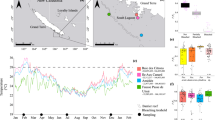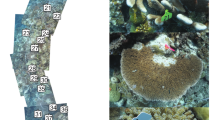Abstract
Resource subsidy regimes, which range from presses to pulses, are common structuring forces in communities, yet research contrasting their effects is lacking. Many coastal marine ecosystems, including estuaries and coral reefs, have experienced increased nutrient subsidies while concurrently shifting to macroalgal dominance; however, the role of subsidy regime in transitions remains unknown. We created concentration–frequency distributions of nutrients in Cook’s Bay, Moorea, French Polynesia, and Carpinteria Salt Marsh Reserve, CA, USA. Both showed relatively high pulses interspersed by press concentrations. We grew dominant macroalgae alone and together in microcosms approximating these subsidy regimes to quantify individual performance and competitive outcomes. Subsidy regime changed growth and competitive abilities of macroalgae from both ecosystems but with divergent effects. In nutrient-limited reefs, different species were favoured under each enrichment regime, suggesting a fluctuating nutrient environment enhances diversity. In contrast, in eutrophic estuaries, enrichment of both regimes facilitated a single competitive dominant, suppressing diversity. Functional form groups did not predict responses to subsidy regime, likely because classifications ignore temporal variability in resource supplies. Because climate change will alter rainfall patterns globally, further accelerating nutrient subsidies from land to sea, understanding species’ responses to nutrient subsidy regimes is key to predicting the fate of coastal communities.



Similar content being viewed by others
References
Alldredge, A., and C. Carlson. 2013. Coral reef: water column: nearshore water profiles, CTD, primary production, and chemistry, ongoing since 2005. Dataset knb-lter-mcr.10.32, Moorea Coral Reef Long Term Ecological Research. Santa Barbara: University of California.
Bakelaar, R.G., and E.P. Odum. 1978. Community and population level responses to fertilization in an old- field ecosystem. Ecology 59: 660–665.
Bellwood, D.R., A.S. Hoey, and J.H. Choat. 2003. Limited functional redundancy in high diversity systems: resilience and ecosystem function on coral reefs. Ecology Letters 6 (4): 281–285.
Bellwood, D.R., T.P. Hughes, C. Folke, and M. Nyström. 2004. Confronting the coral reef crisis. Nature 429: 827–833.
Boyer, K.E., and P. Fong. 2005. Macroalgal-mediated transfers of water column nitrogen to intertidal sediments and salt marsh plants. Journal of Experimental Marine Biology and Ecology 321 (1): 59–69.
Boyle, K.A., P. Fong, and K. Kamer. 2004. Spatial and temporal patterns in sediment and water column nutrients in an eutrophic southern California estuary. Estuaries 27: 254–267.
Briceño, H.O. and Boyer, J. N. 2012. Annual Report of the Water Quality Monitoring Project for the Water Quality Protection Program of the Florida Keys National Marine Sanctuary. SERC Research Reports. 113. http://digitalcommons.fiu.edu/sercrp/113.
Chesson, P., R.L. Gebauer, S. Schwinning, N. Huntly, K. Wiegand, M.S.K. Ernest, A. Sher, A. Novoplansky, and J.F. Weltzin. 2004. Resource pulses, species interactions, and diversity maintenance in arid and semi-arid environments. Oecologia 141 (2): 236–253.
Clausing, R.J., and P. Fong. 2016. Environmental variability drives rapid and dramatic changes in nutrient limitation of tropical macroalgae with different ecological strategies. Coral Reefs 35 (2): 669–680.
Connell, J.H., T.P. Hughes, and C.C. Wallace. 1997. A 30-year study of coral abundance, recruitment, and disturbance at several scales in space and time. Ecological Monographs 67 (4): 461–488.
Cortés-Avizanda, A., R. Jovani, M. Carrete, and J.A. Donazár. 2012. Resource unpredictability promotes species diversity and coexistence in an avian scavenger guild: a field experiment. Ecology 93 (12): 2570–2579.
De'ath, G., and K. Fabricius. 2010. Water quality as a regional driver of coral biodiversity and macroalgae on the Great Barrier Reef. Ecological Applications 20 (3): 840–850.
Dollar, S.J., and M.J. Atkinson. 1992. Effects of nutrient subsidies from groundwater to nearshore marine ecosystems off the island of Hawaii. Estuarine, Coastal and Shelf Science 35 (4): 409–424.
Fabricius, K.E. 2005. Effects of terrestrial runoff on the ecology of corals and coral reefs: review and synthesis. Marine Pollution Bulletin 50 (2): 125–146.
Fedriani, J.M., T.K. Fuller, and R.M. Sauvajot. 2001. Does availability of anthropogenic food enhance densities of omnivorous mammals? An example with coyotes in southern California. Ecography 24 (3): 325–331.
Field, J.G., C.L. Griffiths, E.A. Linley, R.A. Carter, and P. Zoutendyk. 1980. Upwelling in a nearshore marine ecosystem and its biological implications. Estuarine and Coastal Marine Science 11 (2): 133–150.
Fong, C.R., and P. Fong. 2014. Why species matter: an experimental assessment of assumptions and predictive ability of two functional-group models. Ecology 95 (8): 2055–2061.
Fong, P., J.J. Fong, and C.R. Fong. 2004. Growth, nutrient storage, and release of dissolved organic nitrogen by Enteromorpha intestinalis in response to pulses of nitrogen and phosphorus. Aquatic Botany 78 (1): 83–95.
Fong, P. and Kennison, R.L. 2010. Phase shifts, alternative stable states, and the status of southern California Lagoons. In: Kennish MJ, Pearl HW (eds) Coastal lagoons: critical habitats of environmental change. CRC, New York, 164: 227–251.
Fong, P. 2008. Macroalgal-dominated ecosystems. In: Nitrogen in the marine environment. E. J. Carpenter and D.G Capone (eds). 917–948. Academic Press.
Goldberg, D.E., and T.E. Miller. 1990. Effects of different resource additions on species diversity in an annual plant community. Ecology 71: 213–225.
González-De Zayas, R., M. Merino-Ibarra, M.F. Soto-Jiménez, and F.S. Castillo-Sandoval. 2013. Biogeochemical responses to nutrient inputs in a Cuban coastal lagoon: runoff, anthropogenic, and groundwater sources. Environmental Monitoring and Assessment 185 (12): 10101–10114.
Green, L., M. Sutula, and P. Fong. 2014. How much is too much? Identifying benchmarks of adverse effects of macroalgae on the macrofauna in intertidal flats. Ecological Applications 24 (2): 300–314.
Hillebrand, H., D.S. Gruner, E.T. Borer, M.E. Bracken, E.E. Cleland, J.J. Elser, W.S. Harpole, J.T. Ngai, E.W. Seabloom, J.B. Shurin, and J.E. Smith. 2007. Consumer versus resource control of producer diversity depends on ecosystem type and producer community structure. Proceedings of the National Academy of Sciences 104 (26): 0904–10909.
IPCC. 2014. Climate change 2014: Synthesis report. In Contribution of working groups I, II and III to the fifth assessment report of the intergovernmental panel on climate change, ed. Core Writing Team, R.K. Pachauri, and L.A. Meyer. Geneva: IPCC 151 pp.
Kawaguchi, Y., Y. Taniguchi, and S. Nakano. 2003. Terrestrial invertebrate inputs determine the local abundance of stream fishes in a forested stream. Ecology 84 (3): 701–708.
Kennison, R.L., and P. Fong. 2013. High amplitude tides that result in floating mats decouple algal distribution from patterns of recruitment and nutrient sources. Marine Ecology Progress Series 494: 73–86.
Kennison, R.L., K. Kamer, and P. Fong. 2011. Rapid nitrate uptake rates and large short-term storage capacities may explain why opportunistic green macroalgae dominate shallow eutrophic estuaries. Journal of Phycology 47 (3): 483–494.
Lewis, S.M., J.N. Norris, and R.B. Searles. 1987. The regulation of morphological plasticity in tropical reef algae by herbivory. Ecology 68 (3): 636–641.
Lewis, S.M. 1986. The role of herbivorous fishes in the organization of a Caribbean reef community. Ecological Monographs 56 (3): 183–200.
Littler, M.M., and D.S. Littler. 1980. The evolution of thallus form and survival strategies in benthic marine macroalgae: field and laboratory tests of a functional form model. American Naturalist 116: 25–44.
Lovelock, C.E., I.C. Felelr, M.F. Adame, R. Reef, H.M. Penrose, L. Wei, and M.C. Ball. 2011. Intense storms and the delivery of materials that relieve nutrient limitations in mangroves of an arid zone estuary. Functional Plant Biology 38 (6): 514–522.
Murphy, S.M., G.M. Wimp, D. Lewis, and R.F. Denno. 2012. Nutrient presses and pulses differentially impact plants, herbivores, detritivores and their natural enemies. PloS One 7 (8): e43929.
Odum, H.T., and E.P. Odum. 1955. Trophic structure and productivity of a windward coral reef community on Eniwetok Atoll. Ecological Monographs 25 (3): 291–320.
Palumbi, S.R. 2003. Ecological subsidies alter the structure of marine communities. Proceedings of the National Academy of Sciences 100 (21): 11927–11928.
Savage, C., S.F. Thrush, A.M. Lohrer, and J.E. Hewitt. 2012. Ecosystem services transcend boundaries: estuaries provide resource subsidies and influence functional diversity in coastal benthic communities. PloS One 7 (8): e42708.
Singer, G.A., and T.J. Battin. 2007. Anthropogenic subsidies alter stream consumer-resource stoichiometry, biodiversity, and food chains. Ecological Applications 17 (2): 376–389.
Smith, S.V., W.J. Kimmerer, E.A. Laws, R.E. Brock, and T.W. Walsh. 1981. Kaneohe Bay sewage diversion experiment: perspectives on ecosystem responses to nutritional perturbation. Pacific Science 35 (4): 279–395.
Spiller, D.A., J. Piovia-Scott, A.N. Wright, L.H. Yang, G. Takimoto, T.W. Schoener, and T. Iwata. 2010. Marine subsidies have multiple effects on coastal food webs. Ecology 91 (5): 1424–1434.
Stearns, S.C. 1976. Life-history tactics: a review of the ideas. Quarterly Review of Biology 51: 3–47.
Steneck, R.S., and M.N. Dethier. 1994. A functional group approach to the structure of algal-dominated communities. Oikos 69 (3): 476–498.
Stewart, H.L. 2006. Morphological variation and phenotypic plasticity of buoyancy in the macroalga Turbinaria ornata across a barrier reef. Marine Biology 149 (4): 721–730.
Teichberg, M., S.E. Fox, Y.S. Olsen, I. Valiela, P. Martinetto, O. Iribarne, E.Y. Muto, M.A. Petti, T.N. Corbisier, M. Soto-Jiménez, F. Páez-Osuna, P. Castro, H. Freitas, A. Zitelli, M. Cardinaletti, and D. Tagliapietra. 2010. Eutrophication and macroalgal blooms in temperate and tropical coastal waters: nutrient enrichment experiments with Ulva spp. Global Change Biology 16 (9): 2624–2637.
Tilman, D., and J.A. Downing. 1994. Biodiversity and stability in grasslands. Nature 367: 363–365.
Tilman, D. 1990. Constraints and tradeoffs: toward a predictive theory of competition and succession. Oikos 58: 3–15.
Vitousek, P.M., J.D. Aber, R.W. Howarth, G.E. Likens, P.A. Matson, D.W. Schindler, W.H. Schlesinger, and D.G. Tilman. 1997. Human alteration of the global nitrogen cycle: sources and consequences. Ecological Applications 7 (3): 737–750.
Weber, M.J., and M.L. Brown. 2013. Continuous, pulsed and disrupted nutrient subsidy effects on ecosystem productivity, stability, and energy flow. Ecosphere 4 (2): 1–13.
Wetz, M.S., and H.W. Paerl. 2008. Estuarine phytoplankton responses to hurricanes and tropical storms with different characteristics (trajectory, rainfall, winds). Estuaries and Coasts 31 (2): 419–429.
Wilson, S.D., and D.G. Tilman. 1991. Components of plant competition along an experimental gradient of nitrogen availability. Ecology 72: 1050–1065.
Worm, B., H.K. Lotze, H. Hillebrand, and U. Sommer. 2002. Consumer versus resource control of species diversity and ecosystem functioning. Nature 417 (6891): 848–851.
Yang, L.H., J.L. Bastow, K.O. Spence, and A.N. Wright. 2008. What can we learn from resource pulses. Ecology 89 (3): 621–634.
Acknowledgments
Thank you to Tonya Kane, Tim White, Casey Sheridan, and Nick Frasier, Kaylee Griffen, Katherine Langel, and Veronica Jo. This is contribution #220 of UC Berkeley’s Gump South Pacific Research Station.
Author information
Authors and Affiliations
Corresponding author
Additional information
Communicated by Paul A. Montagna
CRF and PF designed and performed the experiment, analysed the data, and wrote the MS.
Rights and permissions
About this article
Cite this article
Fong, C.R., Fong, P. Nutrient Fluctuations in Marine Systems: Press Versus Pulse Nutrient Subsidies Affect Producer Competition and Diversity in Estuaries and Coral Reefs. Estuaries and Coasts 41, 421–429 (2018). https://doi.org/10.1007/s12237-017-0291-5
Received:
Revised:
Accepted:
Published:
Issue Date:
DOI: https://doi.org/10.1007/s12237-017-0291-5




